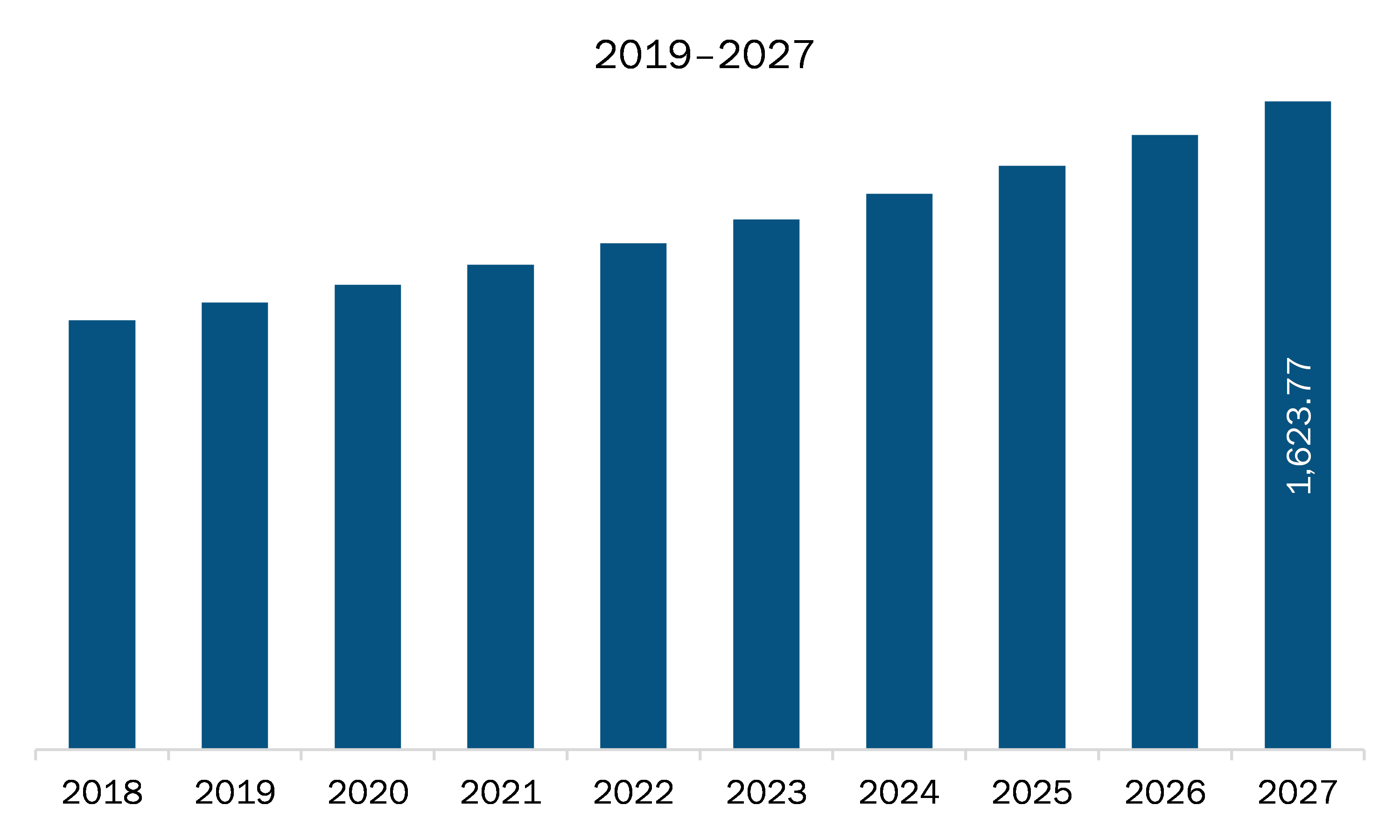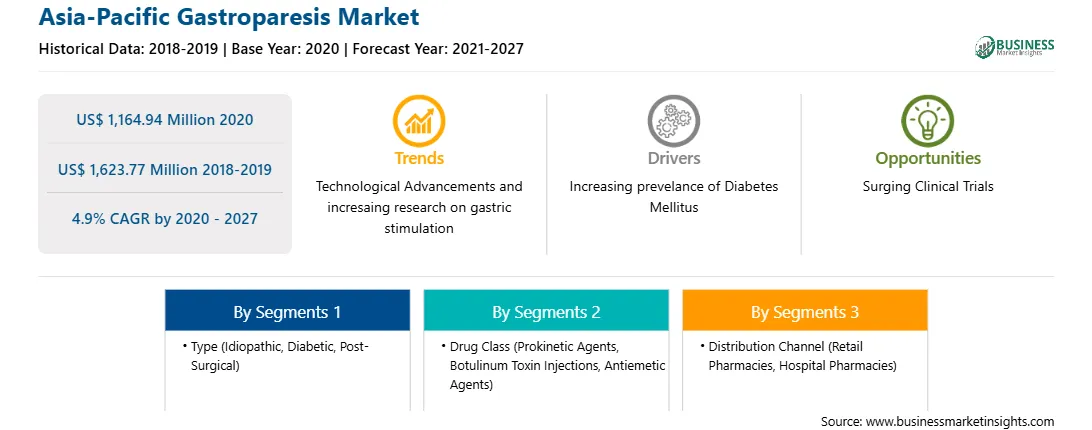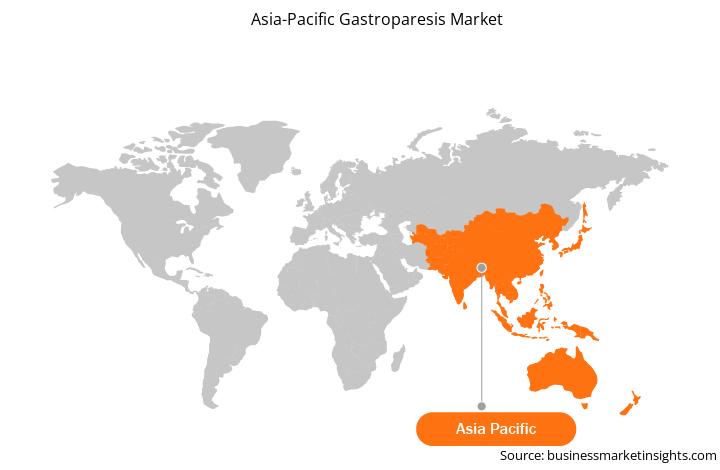APAC includes countries such as China, Japan, India, Australia, South Korea, and Rest of APAC. This region accounted for over fastest growing region of the global Gastroparesis market in 2019 owing to the large diabetic patient population, increasing number of research studies, growing government support, and increasing number of startups, pharmaceutical and biotech companies in this region. Gastroparesis (Gp) is a chronic disease with clinical symptoms of early satiety, nausea, bloating, vomiting, and abdominal pain. The rest of APAC Gastroparesis market is attributed to rising webinar, research studies and conferences in gastroparesis market. For instance, in April 2019, the Philippines Medical Association has conducted webinar on “Diabetic Gastroparesis and GI concerns in Diabetes “. Moreover, in November 2020, Journal of Neurogastroenterology and Motility, published a report on Knowledge, Attitude, and Practice Survey of Gastroparesis in Asia by Asian Neurogastroenterology and Motility Association Running Title: Gastroparesis in Asia. The Singapore, Philippines, South Korea, Taiwan, Thailand Vietnam) participated in the survey. Thus, the factors is likely to boost the gastroparesis market in forecast year.
Countries in APAC are facing challenges due to increasing incidences of COVID-19. The outbreak has severely affected the pharmaceutical industry and imposed supply chain disruptions; moreover, low-income countries face additional challenges due to the shortage of healthcare infrastructure, decreasing in demand of gastroparesis drugs such as prokinetic agents, botulinum toxin injection, antiemetic agents, and others. Moreover, the governments have preferred to continue to permit business operations and economic activities. Thus, the supply of the consumer health products or over the counter drug such as anti-emetic and prokinetic is less affected. For instance, India is among the largest hub for pharmaceutical manufacturing. The country contributes to the majority shares of supplies generic and branded drugs world-wide. The manufacturers are operating with full capacity. Thus, it is expected to maintain the demand and supply of the products in the associated markets. The outbreak has severely affected the pharmaceutical industry ad-imposed supply chain disruptions; moreover, low-income countries face additional challenges due to the shortage of healthcare infrastructure. Restrictive measures have been put forth in South Korea, Malaysia, Singapore, the Philippines, and India to prevent disease transmission.

Strategic insights for the Asia-Pacific Gastroparesis provides data-driven analysis of the industry landscape, including current trends, key players, and regional nuances. These insights offer actionable recommendations, enabling readers to differentiate themselves from competitors by identifying untapped segments or developing unique value propositions. Leveraging data analytics, these insights help industry players anticipate the market shifts, whether investors, manufacturers, or other stakeholders. A future-oriented perspective is essential, helping stakeholders anticipate market shifts and position themselves for long-term success in this dynamic region. Ultimately, effective strategic insights empower readers to make informed decisions that drive profitability and achieve their business objectives within the market.

| Report Attribute | Details |
|---|---|
| Market size in 2020 | US$ 1,164.94 Million |
| Market Size by 2027 | US$ 1,623.77 Million |
| Global CAGR (2020 - 2027) | 4.9% |
| Historical Data | 2018-2019 |
| Forecast period | 2021-2027 |
| Segments Covered |
By Type
|
| Regions and Countries Covered | Asia-Pacific
|
| Market leaders and key company profiles |
The geographic scope of the Asia-Pacific Gastroparesis refers to the specific areas in which a business operates and competes. Understanding local distinctions, such as diverse consumer preferences (e.g., demand for specific plug types or battery backup durations), varying economic conditions, and regulatory environments, is crucial for tailoring strategies to specific markets. Businesses can expand their reach by identifying underserved areas or adapting their offerings to meet local demands. A clear market focus allows for more effective resource allocation, targeted marketing campaigns, and better positioning against local competitors, ultimately driving growth in those targeted areas.

The gastroparesis market in APAC is expected to grow from US$ 1,164.94 million in 2020 to US$ 1,623.77 million by 2027; it is estimated to grow at a CAGR of 4.9% from 2020 to 2027. Diabetes mellitus is a life-threatening chronic disease mainly caused by the body’s inability to produce insulin or effectively utilize it. Diabetes is one of the health emergencies of the 21st century. According to a report published by International Diabetes Federation (IDF) in 2019, 1 in 11 people in the world are suffering from diabetes. In addition, the National Institutes of Health (NIH) also reported that the incidence of type 1 diabetes is increasing rapidly, and the disease is affecting a significant number of children and teenagers. Diabetes is one of the prominent known causes of gastroparesis. The condition is characterized by damaged nerves, especially involving vagus nerves and stomach wall cells. The damage to vagus nerves affects muscle motility of stomach and small intestine.
The APAC gastroparesis market is segmented on the basis of type, drug class, distribution channel, and country. The APAC gastroparesis market, by type, is segmented into idiopathic, diabetic, post-surgical, and others. The idiopathic segment held the largest share of the market in 2019. The APAC gastroparesis market, by drug class type, is segmented into prokinetic agents, botulinum toxin injection, and antiemetic agents. The prokinetic agents segment held the largest share of the market in 2019. Based on distribution channel, the APAC gastroparesis market is segmented into retail pharmacies, hospital pharmacies, and others. The hospital pharmacies segment held the largest share of the market in 2019. Based on country, the APAC gastroparesis market is segmented into Australia, China, India, Japan, South Korea, and rest of APAC. Japan held the largest market share in 2019.
A few major primary and secondary sources referred to for preparing this report on the gastroparesis market in APAC are company websites, annual reports, financial reports, national government documents, and statistical database, among others. Major companies listed in the report are Allergan Plc; Bausch Health Companies Inc. (Salix Pharmaceuticals, Ltd.); Ipca Laboratories Ltd.; Johnson and Johnson Services, Inc.; Pfizer Inc.; and TEVA PHARMACEUTICAL INDUSTRIES LTD.
The Asia-Pacific Gastroparesis Market is valued at US$ 1,164.94 Million in 2020, it is projected to reach US$ 1,623.77 Million by 2027.
As per our report Asia-Pacific Gastroparesis Market, the market size is valued at US$ 1,164.94 Million in 2020, projecting it to reach US$ 1,623.77 Million by 2027. This translates to a CAGR of approximately 4.9% during the forecast period.
The Asia-Pacific Gastroparesis Market report typically cover these key segments-
The historic period, base year, and forecast period can vary slightly depending on the specific market research report. However, for the Asia-Pacific Gastroparesis Market report:
The Asia-Pacific Gastroparesis Market is populated by several key players, each contributing to its growth and innovation. Some of the major players include:
The Asia-Pacific Gastroparesis Market report is valuable for diverse stakeholders, including:
Essentially, anyone involved in or considering involvement in the Asia-Pacific Gastroparesis Market value chain can benefit from the information contained in a comprehensive market report.